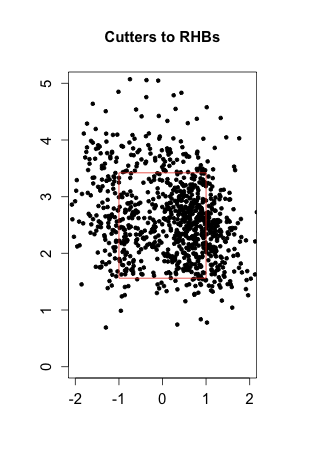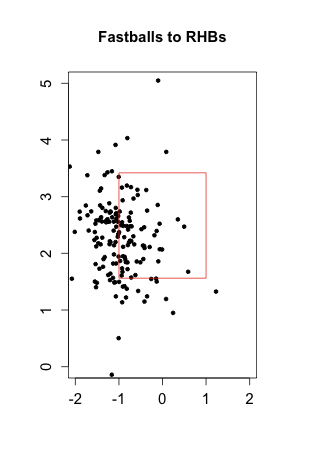
| F/X Visualizations | October 02, 2009 |
For my last post of the regular season I wanted to examine one of the most singular and interesting players in major league baseball, Mariano Rivera. I know I have written about him before but the amazing Sports Illustrated cover of him inspired me to look deeper into his pitchf/x numbers.
In two months Rivera will turn forty and the average speed on his cutter is down a couple MPH in the last couple years, but his performance is still amazing. Unless something ridiculous happens in the next couple days he will finish up his ninth consecutive year with a FIP under 3, sixth out of the last seven years with an ERA under 2 and 12th of the last 13 years with at least 30 saves.
Rivera, famously, throws a cutter almost exclusively. He mixes in a four-seam fastball about 15% of the time to RHBs, but only 1% to lefties. So against RHBs it is about 85% cutters and against LHBs almost all cutters. As I have mentioned before his cutter has an incredible bimodal horizontal location distribution, which I have seen in no other pitch. Here it is to lefties, about 58% of the pitches inside to LHBs (Rivera's glove-side):

Here are his cutters to RHBs, 64% outside (Rivera's glove-side):

His fastball is thrown extremely inside to RHBs.

Effectively he has two pitches to LHBs (inside and outside cutter) and three to RHBs (inside and outside cutter and an inside four-seam fastball). Throughout this article I classify each pitch as either inside (x<0 to RHBs, x>0 to LHBs) or outside (x>0 to RHBs, x<0 to LHBs). Here is how the five pitches do by run value and some other per-pitch-metrics. FA denotes fastball, FCi inside cutter, rv100 is the run value per 100 pitches with negative good, whiff is the percentage of swings that miss the ball, oswing is the percentage of pitches out of the zone swung at, called is called strikes per pitch, gb% is ground balls per ball in play, iff% infield flies per ball in play and slgcon is slugging on contacted pitches.
rhb-FA rhb-FCi rhb-FCo lhb-FCi lhb-FCo
rv100 -1.3 -0.2 -1.8 -3.6 -2.5
whiff 0.10 0.25 0.26 0.17 0.21
oswing 0.43 0.29 0.36 0.50 0.18
called 0.11 0.21 0.16 0.11 0.36
gb% 0.63 0.42 0.44 0.55 0.69
iff% 0.04 0.15 0.06 0.20 0.0
slgcont 0.333 0.597 0.408 0.273 0.408
Generally he gets more whiffs against RHBs, but much poorer contact against LHBs. His slugging on contact against lefties with his inside pitch is 0.273, much lower than the average BABIP. Amazing. The result is his remarkable reverse platoon split, evident in the run value numbers. The glove-side version of his cutter is better than the arm-side version, that is inside to lefties (Rivera's glove-side) is better than outside to lefties (Rivera's arm-side) and outside to righties (Rivera's glove-side) is better than inside (Rivera's arm-side) to righties.
Rivera also provides a really interesting place to start to look at pitch sequencing. I think that pitch sequencing is the next big area for pitchf/x analysts to examine. It is something that Joe Sheehan, Josh Kalk, Max Marchi and Jonathan Hale have looked at, but for the most part is understudied.
Rivera offers a relatively simple jumping off point since he has so few pitch types. In this case I am going to look at how the location of last pitch influences the success of the next one. To keep things even simpler I am going to lump together his inside four-seam fastball and inside cutter to RHBs.
Proportion of pitches thrown inside
vLHB vRHB
all 0.58 0.45
following inside pitch 0.63 0.55
following outside pitch 0.40 0.37
Against both RHBs and LHBs he is more likely to throw inside after an inside pitch and more likely to throw outside after an outside pitch. I am not sure if this is because Rivera knows there are certain batters who have trouble with inside or outside pitching and throws them one or the other more frequently. Or, alternatively, he might be playing a reverse expectation game, after coming inside he thinks the batter expects it outside, so he goes back inside again. I am not sure.
Here is how the location of the last pitch affects the current.
rv100 vLHBs
inside outside
following inside pitch -3.9 -3.4
following outside pitch -2.8 -2.3
rv100 vRHBs
inside outside
following inside pitch -1.7 -0.4
following outside pitch 1.4 -2.7
Against LHBs the difference is not statistically significant, but against RHBs it is. In that case an inside pitch does better after an inside pitch and an outside pitch does better after an outside pitch. So Rivera is correct in his sequencing. I am not sure why the pattern shows up only for RHBs. This is just the tip of the iceberg in terms of how pitch sequencing affects success, but is an interesting first step.
Another great season for Rivera, more data for folks like me to see just how he does it.
Comments
Nice article Dave. Max Marchi also has written on pitch sequencing in this article http://www.hardballtimes.com/main/article/master-of-fooling/. I know that you are familiar with Max's work and that it was just an oversight to not include him in the list with the other three authors that have written on this subject.
Posted by: Peter Jensen at October 2, 2009 12:24 PM
Good stuff, Dave.
Can you give the breakdown for that last rv100 vRHBs inside/outside table like you did for the earlier table with whiff, oswing, called, etc.?
I'm curious what the RHBs are doing with his inside pitches that they aren't doing with his outside pitches (following an outside pitch).
Posted by: Mike Fast at October 2, 2009 12:53 PM
I think it's interesting also to see the white stripe or gap running right down the middle of the strike zone where he DOESN'T throw. That's pretty freakish control.
Posted by: Taz at October 4, 2009 8:03 AM
Peter,
That was an oversight on my part. Thanks for bringing it to my attention. I have edited the article to correct this.
Mike good question. Here is the breakdown of those metrics to RHBs.
I am not entirely sure, but it looks to me like RHBs really sit on inside pitches after outside pitches. So when he goes outside-then-inside they have an surprisingly high .690 slugging on contact. But when he goes outside-outside, they are waiting for inside and have a big 30% whiff rate. Just a guess.
It looks like batters do poorly on inside-then-inside because of poor contact.
Taz, yeah that gap in the middle is striking. It was the topic of one of my earlier posts.
Posted by: Dave Allen at October 5, 2009 7:35 AM